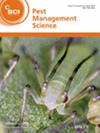求助PDF
{"title":"核受体 E78 的 RNAi 可抑制蜘蛛螨蜕皮过程中角质层的形成。","authors":"Zhuo Li,Qingyan Li,Qixiang Peng,Guy Smagghe,Gang Li","doi":"10.1002/ps.8484","DOIUrl":null,"url":null,"abstract":"BACKGROUND\r\nThe two-spotted spider mite, Tetranychus urticae, is an important pest mite in agriculture worldwide. E78, as a member of the nuclear receptor superfamily and a downstream responsive gene of ecdysteroids, plays a crucial role in regulating physiological behaviors such as development and reproduction in insects. However, its function in mites remains unclear. The aim of this study was to explore how E78 functions in the molting process of spider mites.\r\n\r\nRESULTS\r\nIn this study, reverse transcription quantitative polymerase chain reaction (RT-qPCR) experiments to analyze the expression pattern of TuE78 during the development of Tetranychus urticae, demonstrated that the expression level of TuE78 was higher during the molting state than that after the completion of molting, and it reached a peak expression level when the deutonymph mites entered the molting stage. RNA interference (RNAi)-mediated gene-silencing of TuE78 resulted in 95% deutonymph mite molt failure. A series of analysis under a light microscope, and scanning and transmission electron microscopy revealed that RNAi mites died within the exuvium without ecdysis, and that apolysis had started but the new cuticle was thin and the typical cuticular lamellae were absent, indicating blockage of the post-apolysial processes and explaining molt failure. Hence, transcriptome sequencing confirmed that the expression of cuticle protein and lipid metabolism-related genes was significantly affected after TuE78 silencing.\r\n\r\nCONCLUSION\r\nThis study demonstrated that TuE78 participates in the molting process of Tetranychus urticae by regulating the post-apolysial processes with the formation of new cuticle and successful ecdysis. This in turn suggests the potential of TuE78 as a target for pest mite control and provides a theoretical basis for further exploration of the molecular regulatory mechanism of spider mite molting. © 2024 Society of Chemical Industry. Published by John Wiley & Sons Ltd.","PeriodicalId":218,"journal":{"name":"Pest Management Science","volume":"208 1","pages":""},"PeriodicalIF":3.8000,"publicationDate":"2024-10-14","publicationTypes":"Journal Article","fieldsOfStudy":null,"isOpenAccess":false,"openAccessPdf":"","citationCount":"0","resultStr":"{\"title\":\"RNAi of nuclear receptor E78 inhibits the cuticle formation in the molting process of spider mite, Tetranychus urticae.\",\"authors\":\"Zhuo Li,Qingyan Li,Qixiang Peng,Guy Smagghe,Gang Li\",\"doi\":\"10.1002/ps.8484\",\"DOIUrl\":null,\"url\":null,\"abstract\":\"BACKGROUND\\r\\nThe two-spotted spider mite, Tetranychus urticae, is an important pest mite in agriculture worldwide. E78, as a member of the nuclear receptor superfamily and a downstream responsive gene of ecdysteroids, plays a crucial role in regulating physiological behaviors such as development and reproduction in insects. However, its function in mites remains unclear. The aim of this study was to explore how E78 functions in the molting process of spider mites.\\r\\n\\r\\nRESULTS\\r\\nIn this study, reverse transcription quantitative polymerase chain reaction (RT-qPCR) experiments to analyze the expression pattern of TuE78 during the development of Tetranychus urticae, demonstrated that the expression level of TuE78 was higher during the molting state than that after the completion of molting, and it reached a peak expression level when the deutonymph mites entered the molting stage. RNA interference (RNAi)-mediated gene-silencing of TuE78 resulted in 95% deutonymph mite molt failure. A series of analysis under a light microscope, and scanning and transmission electron microscopy revealed that RNAi mites died within the exuvium without ecdysis, and that apolysis had started but the new cuticle was thin and the typical cuticular lamellae were absent, indicating blockage of the post-apolysial processes and explaining molt failure. Hence, transcriptome sequencing confirmed that the expression of cuticle protein and lipid metabolism-related genes was significantly affected after TuE78 silencing.\\r\\n\\r\\nCONCLUSION\\r\\nThis study demonstrated that TuE78 participates in the molting process of Tetranychus urticae by regulating the post-apolysial processes with the formation of new cuticle and successful ecdysis. This in turn suggests the potential of TuE78 as a target for pest mite control and provides a theoretical basis for further exploration of the molecular regulatory mechanism of spider mite molting. © 2024 Society of Chemical Industry. Published by John Wiley & Sons Ltd.\",\"PeriodicalId\":218,\"journal\":{\"name\":\"Pest Management Science\",\"volume\":\"208 1\",\"pages\":\"\"},\"PeriodicalIF\":3.8000,\"publicationDate\":\"2024-10-14\",\"publicationTypes\":\"Journal Article\",\"fieldsOfStudy\":null,\"isOpenAccess\":false,\"openAccessPdf\":\"\",\"citationCount\":\"0\",\"resultStr\":null,\"platform\":\"Semanticscholar\",\"paperid\":null,\"PeriodicalName\":\"Pest Management Science\",\"FirstCategoryId\":\"97\",\"ListUrlMain\":\"https://doi.org/10.1002/ps.8484\",\"RegionNum\":1,\"RegionCategory\":\"农林科学\",\"ArticlePicture\":[],\"TitleCN\":null,\"AbstractTextCN\":null,\"PMCID\":null,\"EPubDate\":\"\",\"PubModel\":\"\",\"JCR\":\"Q1\",\"JCRName\":\"AGRONOMY\",\"Score\":null,\"Total\":0}","platform":"Semanticscholar","paperid":null,"PeriodicalName":"Pest Management Science","FirstCategoryId":"97","ListUrlMain":"https://doi.org/10.1002/ps.8484","RegionNum":1,"RegionCategory":"农林科学","ArticlePicture":[],"TitleCN":null,"AbstractTextCN":null,"PMCID":null,"EPubDate":"","PubModel":"","JCR":"Q1","JCRName":"AGRONOMY","Score":null,"Total":0}
引用次数: 0
引用
批量引用
RNAi of nuclear receptor E78 inhibits the cuticle formation in the molting process of spider mite, Tetranychus urticae.
BACKGROUND
The two-spotted spider mite, Tetranychus urticae, is an important pest mite in agriculture worldwide. E78, as a member of the nuclear receptor superfamily and a downstream responsive gene of ecdysteroids, plays a crucial role in regulating physiological behaviors such as development and reproduction in insects. However, its function in mites remains unclear. The aim of this study was to explore how E78 functions in the molting process of spider mites.
RESULTS
In this study, reverse transcription quantitative polymerase chain reaction (RT-qPCR) experiments to analyze the expression pattern of TuE78 during the development of Tetranychus urticae, demonstrated that the expression level of TuE78 was higher during the molting state than that after the completion of molting, and it reached a peak expression level when the deutonymph mites entered the molting stage. RNA interference (RNAi)-mediated gene-silencing of TuE78 resulted in 95% deutonymph mite molt failure. A series of analysis under a light microscope, and scanning and transmission electron microscopy revealed that RNAi mites died within the exuvium without ecdysis, and that apolysis had started but the new cuticle was thin and the typical cuticular lamellae were absent, indicating blockage of the post-apolysial processes and explaining molt failure. Hence, transcriptome sequencing confirmed that the expression of cuticle protein and lipid metabolism-related genes was significantly affected after TuE78 silencing.
CONCLUSION
This study demonstrated that TuE78 participates in the molting process of Tetranychus urticae by regulating the post-apolysial processes with the formation of new cuticle and successful ecdysis. This in turn suggests the potential of TuE78 as a target for pest mite control and provides a theoretical basis for further exploration of the molecular regulatory mechanism of spider mite molting. © 2024 Society of Chemical Industry. Published by John Wiley & Sons Ltd.


